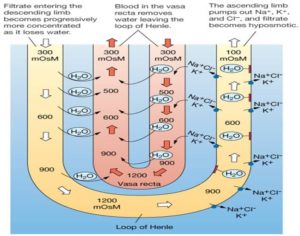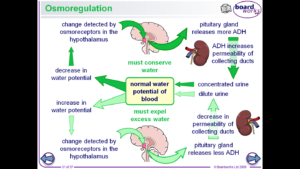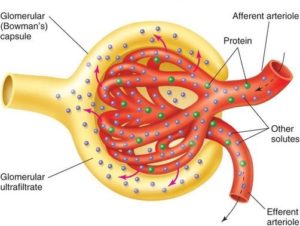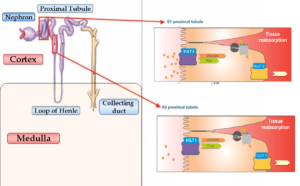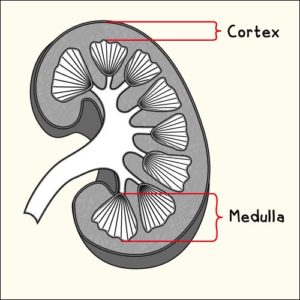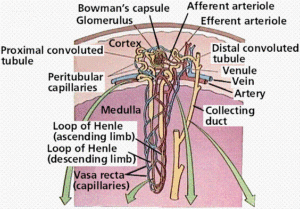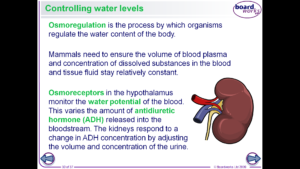Organisms respond to changes in their internal and external environments (AQA A2 Biology) PART 9 of 9 TOPICS
TOPICS: Survival and response Receptors Control of heart rate Nerve impulses Synaptic transmission Skeletal muscles are stimulated to contract by nerves and act as effectors Principals of homeostasis and negative feedback Control of blood glucose concentration Control of blood water potential
Control of blood water potential:
The nephron starts in the cortex (the outer layer of the kidney) at the Bowman’s capsule and then starts to weave where this area is called the proximal convoluted tubule. The nephron from the proximal convoluted tubule enters the medulla (the inner layer of the kidney) where it straightens and descends, curves and ascends back up into the cortex. The ‘U-looking’ bit of the nephron is called The loop of Henlé. The nephron then weaves again which is called distal convoluted tubule and then becomes the collecting duct and descends to become ureter which goes into the bladder. NB: Proximal convoluted tubule and distal convoluted tubule can be abbreviated into PCT and DCT but if you are going to use these abbreviations then you should know what the letters stand for as the whole name can be given in an exam question. The whole of the nephron from the Bowman’s capsule to the collecting duct wrapped around with capillaries to filter the blood to make a filtrate and also to reabsorb any useful molecules for the body called selective reabsorption where at the end it is called renal vein.
The Bowman’s capsule has capillaries in the Bowman’s space called glomerulus which supplied with blood from the renal arteriole called the afferent arteriole. The blood then leaves the glomerulus via an arteriole called the efferent arteriole. A glomerular filtrate is made by a process called ultrafiltration. The afferent arteriole has a larger diameter than the efferent arteriole and so the blood in the afferent arteriole has a higher hydrostatic pressure than the blood in the efferent arteriole. This means that urea, water, amino acids and glucose are forced out of the capillaries into the nephron (Bowman’s capsule). Large proteins and blood cells cannot be forced through as they are too large to go through ultrafiltration. Between the capillary and the Bowman’s capsule the small molecules have to go through 3 layers: the endothelium of the capillary wall, the basement membrane made of collagen in the middle of the capillary and the Bowman’s capsule and the epithelial cells that line the Bowman’s capsule. The filtrate that is in the nephron is called the glomerular filtrate.
Selective reabsorption takes place from the proximal convoluted tubule, loop of Henlé, distal convoluted tubule and collecting duct into the blood . The endothelium cells in the proximal convoluted tubule have microvilli which provide a large surface area to absorb the useful molecules. These include:
- Glucose by facilitated diffusion and active transport. Active transport is also needed for the reabsorption of glucose because facilitated diffusion increases the amount of glucose in the medulla compared to the nephron therefore another process is needed to absorb glucose up the concentration gradient.
- Water by osmosis from the proximal convoluted tubule, loop of Henlé, distal convoluted tubule and collecting duct. The remaining filtrate in the nephron is then sent down the ureter into the bladder.
The loop of Henlé is very important as it plays a role in absorbing water into the capillaries. The loop of Henlé has a descending limb and an ascending limb which makes up the loop. In the ascending limb, Na+ ions are pumped out by active transport out of the ascending limb into the medulla up its concentration gradient. The water potential in the medulla lowers and is lower than the water potential in the ascending limb but the membrane of the ascending limb is impermeable to water therefore water cannot exit the nephron. Only very few Na+ ions come into the descending limb but does not change anything as it has minimal effect. The high concentration of Na+ ions in the medulla causes water to leave the descending limb by osmosis. The filtrate in the descending limb becomes more concentrated but cannot really leave, down its concentration gradient into the medulla as it is relatively impermeable permeable to the Na+ ions. Water is then reabsorbed into the capillary called the vasa recta (the capillary that surrounds the whole of the nephron) by osmosis from the medulla. The filtrate then flows down the descending limb to the bottom of the loop of Henlé where at this point the concentration of Na+ ions is the highest. Na+ ions diffuse out of the nephron into the medulla down its concentration gradient. The medulla now has two regions of Na+ ions where the region that is closest to the bottom of the loop of Henlé which has the highest amount of Na+ ions in the nephron, has the larger concentration. Therefore a concentration gradient is made in the medulla of Na+ ions which allows the maximum amount of water to leave the distal convoluted tubule and along the whole of the collecting duct.
Osmoregulation is the process where organisms regulate the water content in their bodies. This is needed to keep the water content in the body relatively constant. Osmoreceptors in the hypothalamus of the brain detect a change in the water content and so send an electrical impulse to the posterior pituitary gland which releases antidiuretic hormone and in an amount depending on the water potential in the blood. The kidneys respond to this change and so change how concentrated the urine will be. NB: Antidiuretic hormone can be abbreviated into ADH but make sure that when you do use the abbreviated version, you know what it stands for as it can get confusing if the full name was to be given in the exam. If the water potential in the blood is too low the osmoreceptors shrink as water leaves down its concentration gradient from the cell to the blood by osmosis. An electrical impulse is sent to the posterior pituitary gland where ADH is released into the blood in high quantities. This makes the membrane of the collecting duct more permeable to water and so the water leaves by osmosis into the blood making the urine more concentrated. If the water potential of the blood is high the osmoreceptors in the hypothalamus become turgid and sends an electrical impulse to posterior pituitary gland where ADH is made in minimal quantities. This makes the membrane of the collecting duct relatively impermeable to water where not much water is reabsorbed making the urine less concentrated.

